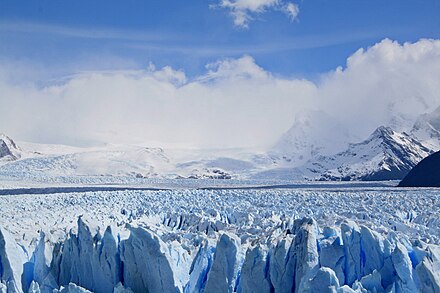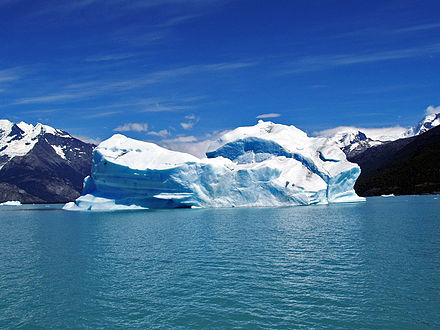Los Glaciares National Park - national park of Argentina

Understand
 Los Glaciares National Park has an area of . It is in the Santa Cruz Province of Argentina and is near the Chile border. Its many glaciers include Perito Moreno, best known for the dramatic icefalls from its front wall, into Lake Argentino. In the north, Mount Fitz Roy's jagged peak rises above the mountain town of El Chaltén and Lake Viedma. Los Glaciares, of which 30% is covered by ice, can be divided in two parts, each corresponding with one of the two elongated big lakes partially contained by the park.
Los Glaciares National Park has an area of . It is in the Santa Cruz Province of Argentina and is near the Chile border. Its many glaciers include Perito Moreno, best known for the dramatic icefalls from its front wall, into Lake Argentino. In the north, Mount Fitz Roy's jagged peak rises above the mountain town of El Chaltén and Lake Viedma. Los Glaciares, of which 30% is covered by ice, can be divided in two parts, each corresponding with one of the two elongated big lakes partially contained by the park.
Lake Argentino, in the south, is the largest in the whole country, and as such dominates this region of Patagonia. Many tourists begin their journey in the town of El Calafate, which is on the shore of the lake. Excursions leave from here by land to the Perito Moreno Glacier. Other excursions venture by boat between the icebergs to many other glaciers, since a majority of them can only be seen by boat.
Lake Viedma, in the north, is home to the Viedma Glacier and Mount Fitz Roy. The village of El Chalten, at the foot of the Fitz Roy Massif, is another starting point into the park (and lacks the AR$100 entrance fee present at the Perito Moreno entrance). This is the most popular spot in the region for those who love to climb and trek with its numerous trails. Although most of these are effectively day trails, there are possibilities for staying overnight in a number of campsites.
History
Los Glaciares National Park was established on May 11, 1937. Due to its magnificent natural beauty, it constitutes being a wonder of the world, and was declared a "World Heritage Site" by UNESCO in 1981.
Landscape
The vegetation is a so-called sub-Antarctic forest. It's less dense than the rainforest on the Chilean side, but significantly greener than the steppe that accompanies you until shortly after Calafate.
Flora and fauna
Hummingbirds, pumas, Andean condors, black-crested buzzard eagles and the rare Huemul, an endangered species of small deer, live here.
Climate
The summer daytime temperatures rise to 20 to 25 degrees, in winter to 0 to 5 degrees. Snow is rare because of the drought, so the area can be visited all year round.
Get in
Los Glaciares National Park can be divided into two different entrances, one near the Lake Argentino and the other near Lake Viedma.
The starting point for a journey to the southern section of the park is the small town of El Calafate. El Chaltén is located in the north of the park, about 220 km by car and 150 km north of Calafate. Calafate has an airport that has regular flights from Buenos Aires, San Carlos de Bariloche, Río Gallegos and several other smaller towns in Patagonia.
Calafate and Chaltén are also served by buses and are also very well networked with each other. There are only regular lines to the region from Río Gallegos. However, there is a wider range of options, especially during the travel season.
El Chalten is the base from which overnight excursions to the Marconi Glacier are launched.
The best way to travel by car is via the Ruta Nacional 3 to Río Gallegos and then via the RP5 to Calafate. This is the only tarred route in the region. Anyone who owns an all-terrain vehicle or has rented it can get to the park more quickly via numerous gravel roads - with a "normal" car this is an extremely slow and breakdown-prone undertaking.
Fees and permits
South (Perito Moreno Glacier)
Admission fees are staggered:
- pensioners and minors under 16: free admission
- students and residents of the Santa Cruz province: 40 ARS (approx. € 2.35) in 2016
- people with permanent residence in Argentina (including foreigners): 200 ARS (approx. 15 €)
- for foreign tourists: 250 ARS (approx. 15 €) for citizens of Mercosur (South America & Mexico), 330 ARS (approx. 20 €) for citizens of other countries.
The park opens at 8:00 a.m. and closes in July at 4:00 p.m., in winter the opening time is extended monthly to 9:00 p.m. (Nov. 7:00 p.m., Dec. 8:00 p.m., Jan + Feb. 9:00 p.m. ), only to shorten it again in the spring
North (El Chalten)
Entry to and use of the campsites in the north is free and possible without a permit. A (free) registration with APN is necessary for the hike to the Laguna Toro and glacier tours.
Get around
Never leave the official paths, due to risk of falling ice. Especially the glacier walls are dangerous, where even pieces 50m long may fall off.
See
.jpg/440px-Top_of_Perito_Moreno_(104862726).jpg)
-
Perito Moreno Glacier, -50.483333°, -73.05°. Probably the best known in the park. It is a geographical exception because it divides an arm of Lake Argentino into two parts. If the water level in the upper arm is high enough, the glacier bursts with a deafening roar. This spectacle occurs roughly every 4 to 10 years and never lasts more than 2 or 3 days.
-
Upsala Glacier, -49.760256°, -73.275411°. Also on Lake Argentino, the largest glacier in the park. It is approached by boats, but its "wall" is less attractive than that of Perito Moreno. The boat tour is still worth it, because you get very close to the glacier and the icebergs that have separated from it. The landscape partly resembles that of Antarctica. The starting point for the hike to the viewpoint at Refugio Upsala can also be reached by boat.
-
The region around Lago Roca in the south of the park is less frequented. Here you can climb the Cerro de los Cristalles / Cerro Cristalles panoramic mountain or take a multi-day hike to the glaciers on Laguna Fría. The best starting point for the southern section of the national park with the Perito Moreno and Upsala glaciers, as well as the region of Lago Roca, is El Calafate .
-
Cerro Fitz Roy. The highest peak of the park. Its characteristic, pointed shape has always attracted climbers from all over the world.
-
The nearby Cerro Torre is therefore very well known.
-
There are many trekking opportunities in the entire area of this massif near El Chaltén.
Do
Buy
Eat
Drink
Sleep
Lodging
There are plenty options to choose from in Calafate and Chaltén. The most exclusive accommodation is probably a hut and hotel complex directly opposite the Perito Moreno Glacier.
Camping
There is no camping site near the Perito Moreno glacier. However, the organized campsite on Lago Roca south of Calafate is particularly attractive, and you can even swim there in summer. Free camping is prohibited in the park.
Backcountry
Go next
Los Glaciares National Park
losglaciares.comSanta Cruz
Primary administrative division